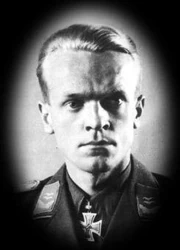| Theodor Nordmann | |
|---|---|
 | |
| Nickname | "Theo" |
| Born | 18 December 1918 |
| Died | 19 January 1945 (aged 26) |
| Place of birth | Dorsten |
| Place of death | near Insterburg |
| Allegiance |
|
| Service/branch |
|
| Years of service | 1937–1945 |
| Rank | Major |
| Unit | StG 1, StG 3 |
| Battles/wars | |
| Awards | Knight's Cross with Oak Leaves and Swords |
Major Theodor Nordmann (born 18 December 1918 in Dorsten – Killed in flying accident 19 January 1945 near Insterburg) was a German World War II Luftwaffe Stuka ace.[Notes 1] He was also a recipient of the Knight's Cross of the Iron Cross with Oak Leaves and Swords (Ritterkreuz des Eisernen Kreuzes mit Eichenlaub und Schwertern). The Knight's Cross of the Iron Cross and its higher grade Oak Leaves and Swords was awarded to recognise extreme battlefield bravery or successful military leadership.
Career
Nordmann joined the Luftwaffe in 1937, and served as a reconnaissance pilot until March 1940, when he transferred to 1/StG 186, flying the Junkers Ju 87 'Stuka'. The unit was originally intended to serve on the aircraft carrier Graf Zeppelin, but in July 1940 was renamed III./StG 1 and flew conventional bombing missions during the battle of France and Battle of Britain. Nordmann was awarded the Iron cross 1st and 2nd class during 1940. In 1941 Normann's unit was relocated to the Mediterranean for actions against Malta, where he claimed a 5,000 ton merchantman sunk.
StG 1 took part in the invasion of Russia in June 1941 and in September 1941, after 200 operations and 20 tanks destroyed, he was awarded the Ritterkreuz.
During the fighting over Orel in the summer of 1942, Nordmann, as Staffelkapitän of 8./StG 1, made his 600th operational mission, the first Stuka pilot to achieve this total.
His radio operator and gunner, Feldwebel Gerhard Rothe, was one of only 15 Stuka gunners to be honored with the Knight's Cross of the Iron Cross.
In January 1945 Nordmann was killed when his Focke-Wulf Fw 190 F-8 (Werknummer 588202—factory number) collided with his wing man, Oberfeldwebel Sroka (Fw 190 F-8 Werknummer 933242) in bad weather north of Insterburg.[1] Nordmann was Gruppenkommandeur of II./SG 3 from October 1943 until his death in January 1945. He claimed some 80 Soviet tanks destroyed and 43,000 gross register tons (GRT) of merchant shipping sunk. He flew almost 1300 combat missions, including roughly 200 with the Fw 190.
Awards
- Verwundetenabzeichen in Silver[2]
- Front Flying Clasp of the Luftwaffe in Gold with Pennant "1.100"[2]
- Combined Pilots-Observation Badge[2]
- "Kreta" Cuffband[2]
- German Cross in Gold on 20 October 1942 as Oberleutnant in the III./Sturzkampfgeschwader 1[3]
- Iron Cross (1939)
- Ehrenpokal der Luftwaffe[2]
- Knight's Cross with Oak Leaves and Swords
- Knight's Cross on 17 September 1941 Leutnant and pilot in the 8./Sturzkampfgeschwader 1[5]
- 214th Oak Leaves on 17 March 1943 as Oberleutnant and acting commander of the III./Sturzkampfgeschwader 1[6][Notes 2]
- 98th Swords on 17 September 1944 as Major and Gruppenkommandeur of II./Schlachtgeschwader 3[5]
Notes
- ↑ For a list of Luftwaffe ground attack aces see List of German World War II Ground Attack aces
- ↑ According to Scherzer on 16 March 1943 as leader of the III./Sturzkampfgeschwader 1.[5]
References
- Citations
- Bibliography
- Berger, Florian (1999) (in German). Mit Eichenlaub und Schwertern. Die höchstdekorierten Soldaten des Zweiten Weltkrieges [With Oak Leaves and Swords. The Highest Decorated Soldiers of the Second World War]. Vienna, Austria: Selbstverlag Florian Berger. ISBN 978-3-9501307-0-6.
- Brütting, Georg (1995) (in German). Das waren die deutschen Stuka-Asse 1939 – 1945 [These were the German Stuka Aces 1939 - 1945]. Stuttgart, Germany: Motorbuch. ISBN 978-3-87943-433-6.
- Fellgiebel, Walther-Peer (2000) (in German). Die Träger des Ritterkreuzes des Eisernen Kreuzes 1939–1945 – Die Inhaber der höchsten Auszeichnung des Zweiten Weltkrieges aller Wehrmachtsteile [The Bearers of the Knight's Cross of the Iron Cross 1939–1945 — The Owners of the Highest Award of the Second World War of all Wehrmacht Branches]. Friedberg, Germany: Podzun-Pallas. ISBN 978-3-7909-0284-6.
- Obermaier, Ernst (1976) (in German). Die Ritterkreuzträger der Luftwaffe 1939–1945 Band II Stuka- und Schlachtflieger [The Knight's Cross Bearers of the Luftwaffe 1941 – 1945 Volume II Dive Bomber and Attack Aircraft]. Mainz, Germany: Verlag Dieter Hoffmann. ISBN 978-3-87341-021-3.
- Patzwall, Klaus D.; Scherzer, Veit (2001) (in German). Das Deutsche Kreuz 1941 – 1945 Geschichte und Inhaber Band II [The German Cross 1941 – 1945 History and Recipients Volume 2]. Norderstedt, Germany: Verlag Klaus D. Patzwall. ISBN 978-3-931533-45-8.
- Scherzer, Veit (2007) (in German). Die Ritterkreuzträger 1939–1945 Die Inhaber des Ritterkreuzes des Eisernen Kreuzes 1939 von Heer, Luftwaffe, Kriegsmarine, Waffen-SS, Volkssturm sowie mit Deutschland verbündeter Streitkräfte nach den Unterlagen des Bundesarchives [The Knight's Cross Bearers 1939–1945 The Holders of the Knight's Cross of the Iron Cross 1939 by Army, Air Force, Navy, Waffen-SS, Volkssturm and Allied Forces with Germany According to the Documents of the Federal Archives]. Jena, Germany: Scherzers Miltaer-Verlag. ISBN 978-3-938845-17-2.
- Thomas, Franz (1998) (in German). Die Eichenlaubträger 1939–1945 Band 2: L–Z [The Oak Leaves Bearers 1939–1945 Volume 2: L–Z]. Osnabrück, Germany: Biblio-Verlag. ISBN 978-3-7648-2300-9.
External links
The original article can be found at Theodor Nordmann and the edit history here.
